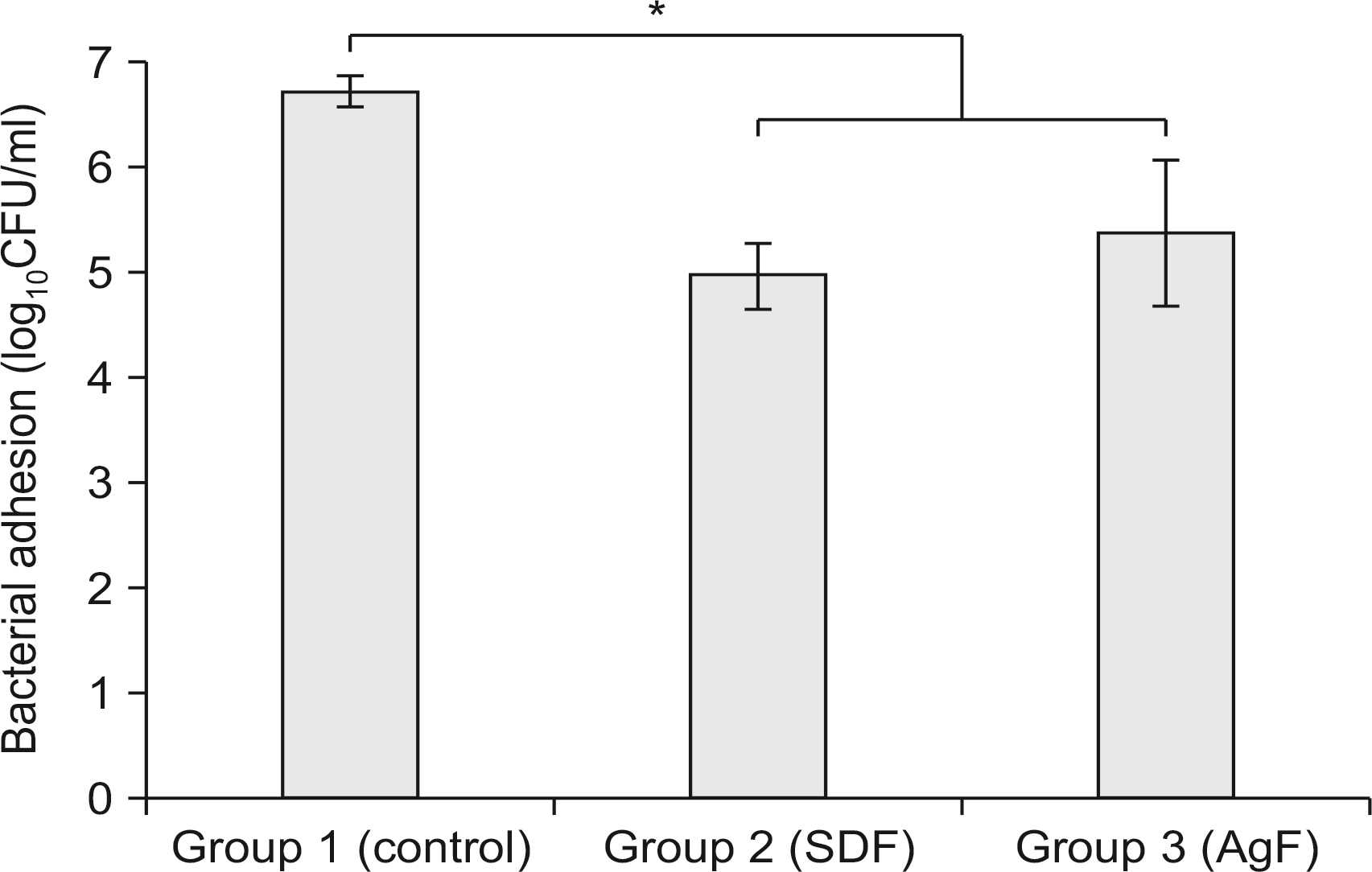J Korean Acad Oral Health.
2022 Sep;46(3):154-157. 10.11149/jkaoh.2022.46.3.154.
Effect of silver fluoride on Streptococcus mutans biofilm and surface of dentin
- Affiliations
-
- 1Department of Pediatric Dentistry, College of Dentistry, Gangneung-Wonju National University, Gangneung, Korea
- KMID: 2534112
- DOI: http://doi.org/10.11149/jkaoh.2022.46.3.154
Abstract
Objectives
This study aimed to evaluate the effect of silver fluoride (AgF) on the formation of cariogenic biofilm and surface of dentin in vitro.
Methods
Bovine dentin specimens with artificial caries were prepared and divided into 3 groups: untreated control, AgF-treated, and silver diamine fluoride (SDF)-treated. Streptococcus mutans cultured in brain heart infusion (BHI) broth was used to induce biofilm. The specimens were placed in a well plate containing BHI broth and S. mutans bacterial suspension, and incubated under aerobic conditions supplemented with 5% CO2 at 37℃ for 24 hours. After the incubation, the specimens were washed twice with phosphate-buffered saline (PBS) and sonicated to obtain a bacterial suspension. The diluted bacterial suspension was then smeared on a blood agar plate and cultured for 72 hours at 5% CO2 and 37℃. Following this, the number of bacterial colony forming units (CFUs) was counted and converted into logarithms for analysis. Additional specimens of each group were observed by scanning electron microscope (SEM). Energy dispersive X-ray spectroscopy (EDS) was also performed for component analysis of the dentin surface.
Results
The number of S. mutans bacterial CFUs was significantly lower in the AgF and SDF groups than in the untreated control group. It was shown that SDF inhibited biofilm formation more than AgF; however, there was no statistical significance. The SEM images showed particles formed after AgF and SDF application were deposited on the dentin. It is confirmed through EDS analysis that the particles contained silver and fluoride ions.
Conclusions
This study confirmed that AgF application effectively inhibited the formation of the early S. mutans biofilm. It is suggested that AgF solution may be effectively used in the clinical setting to prevent caries without occurrence of gingival irritation or bad odors.
Figure
Reference
-
References
1. Shah S, Bhaskar V, Venkatraghavan K, Choudhary P, Trived K. 2014; Silver diamine fluoride: a review and current applications. J Adv Oral Res. 5:25–35. DOI: 10.1177/2229411220140106.
Article2. Crystal YO, Marghalani AA, Ureles SD, Wright JT, Sulyanto R, Divaris K, et al. 2017; Use of silver diamine fluoride for dental caries management in children and adolescents, including those with special health care needs. Pediatr Dent. 39:135E–145E. PMID: 32074885.3. Roberts A, Bradley J, Merkley S, Pachal T, Gopal JV, Sharma D. 2020; Does potassium iodide application following silver diamine fluoride reduce staining of tooth? A systematic review. Aust Dent J. 65:109–117. DOI: 10.1111/adj.12743. PMID: 31900927.
Article4. Zhao IS, Yin IX, Mei ML, Lo ECM, Tang J, Li Q, et al. 2020; Remineralising dentine caries using sodium fluoride with silver nanoparticles: an in vitro study. Int J Nanomedicine. 15:2829–2839. DOI: 10.2147/IJN.S247550. PMID: 32368057. PMCID: PMC7185692.5. Strużycka I. 2014; The oral microbiome in dental caries. Polish J Microbiol. 63:127–135. DOI: 10.33073/pjm-2014-018. PMID: 25115106.
Article6. Schwendicke F, Eggers K, Meyer-Lueckel H, Dörfer C, Kovalev A, Gorb S, et al. 2015; In vitro Induction of residual caries lesions in dentin: comparative mineral loss and nano-hardness analysis. Caries Res. 49:259–265. DOI: 10.1159/000371897. PMID: 25832626.
Article7. Horst JA, Ellenikiotis H, Milgrom PM. 2016; UCSF protocol for caries arrest using silver diamine fluoride: rationale, indications, and consent. J Calif Dent Assoc. 44:16–28. DOI: 10.1038/sj.bdj.2017.311. PMID: 26897901. PMCID: PMC4778976.8. SDI. Riva star aqua [Internet]. Available from: https://www.sdi.com.au/pdfs/instructions/au/riva%20star%20aqua%20Bottle_sdi_ininstructio_au.pdf. cited 2022 Sep 23.9. SDI. Riva star [Internet]. Available from: https://www.sdi.com.au/pdfs/instructions/au/riva%20star%20Bottle_sdi_instructions_au.pdf. cited 2022 Sep 23.10. Craig GG, Powell KR, Cooper MH. 1981; Caries progression in primary molars: 24-month results from a minimal treatment programme. Community Dent Oral Epidemiol. 9:260–265. DOI: 10.1111/j.1600-0528.1981.tb00342.x. PMID: 6955124.
Article11. Turton B, Horn R, Durward C. 2021; Caries arrest and lesion appearance using two different silver fluoride therapies on primary teeth with and without potassium iodide: 12-month results. Clin Exp Dent Res. 7:609–619. DOI: 10.1002/cre2.367. PMID: 33370847. PMID: 44bc3123351e42f8bbb5b287f2e5d953.
Article12. SDI. Riva star aqua [Internet]. Available from: https://www.sdi.com.au/wp-content/uploads/2021/04/2021-August-Jarod-Johnson-DPR-Riva-Star-Aqua.pdf. cited 2022 Aug 09.13. Patel J, Foster D, Smirk M, Turton B, Anthonappa R. 2021; Acidity, fluoride and silver ion concentrations in silver diamine fluoride solutions: a pilot study. Aust Dent J. 66:188–193. DOI: 10.1111/adj.12822. PMID: 33450061.
Article14. Takahashi M, Matin K, Matsui N, Shimizu M, Tsuda Y, Uchinuma S, et al. 2021; Effects of silver diamine fluoride preparations on biofilm formation of Streptococcus mutans. Dent Mater J. 40:911–917. DOI: 10.4012/dmj.2020-341. PMID: 33731542.
Article15. Manuschai J, Talungchit S, Naorungroj S. 2021; Penetration of Silver Diamine Fluoride in Deep Carious Lesions of Human Permanent Teeth: An In Vitro Study. Int J Dent. 2021:3059129. DOI: 10.1155/2021/3059129. PMID: 34976061. PMCID: PMC8716243. PMID: eb6503ed12d845128c5cb773a955c877.
Article16. Jia L, Tao S, Yang J, Liang K, Yu Z, Gao Y, et al. 2021; Adhesion of Streptococcus mutans on remineralized enamel surface induced by poly (amido amine) dendrimers. Colloids Surf B Biointerfaces. 197:111409. DOI: 10.1016/j.colsurfb.2020.111409. PMID: 33147567.17. Nakajo K, Komori R, Ishikawa S, Ueno T, Suzuki Y, Iwami Y, et al. 2006; Resistance to acidic and alkaline environments in the endodontic pathogen Enterococcus faecalis. Oral Microbiol Immunol. 21:283–288. DOI: 10.1111/j.1399-302X.2006.00289.x. PMID: 16922926.
Article18. Hamama HH, You CK, Burrow MF. 2015; Effect of silver diamine fluoride and potassium iodide on residual bacteria in dentinal tubules. Aust Dent J. 60:80–87. DOI: 10.1111/adj.12276. PMID: 25721282.
Article
- Full Text Links
- Actions
-
Cited
- CITED
-
- Close
- Share
- Similar articles
-
- Comparison of Cariogenic Characteristics between Fluoride-sensitive and Fluoride-resistant Streptococcus mutans
- The Effect of Silver Diamine Fluoride on Salivary Biofilm
- Surface Roughness of Dentin and Formation of Early Cariogenic Biofilm after Silver Diamine Fluoride and Potassium Iodide Application
- Antimicrobial Persistence of Silver Diamine Fluoride and Silver Fluoride against Streptococcus mutans
- Antibacterial Effects of Silver Fluoride and Difluorosilane-based Varnish on Streptococcus mutans




